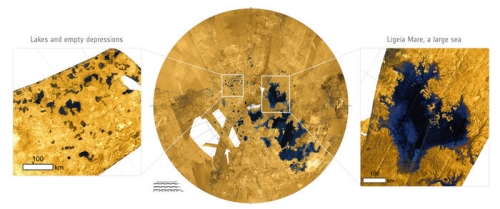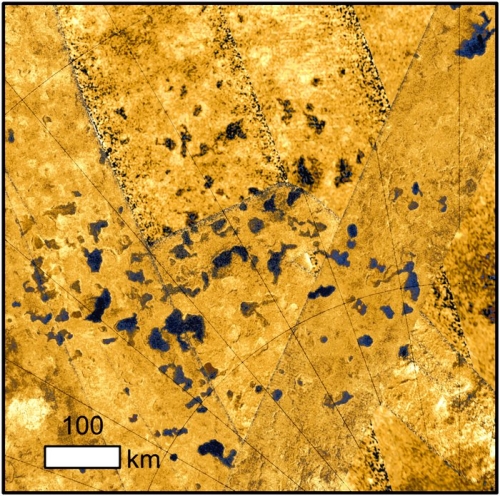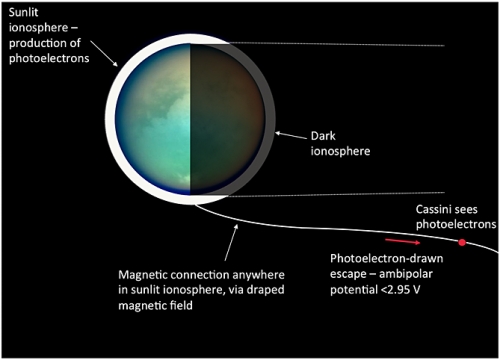It’s hard to consider a place with surface temperatures of -180°C ‘Earthlike,’ but there are reasons why we see the term so often applied to Titan. The most striking of these is the presence of surface lakes and seas, a phenomenon found nowhere else in the Solar System. The temperatures are cold enough to make the circulating fluid liquid methane and ethane rather than water, but we see things in Cassini imagery that are strikingly familiar, including seas fed by river-like channels and large numbers of shallow lakes that appear in flatter areas.
The European Space Agency’s Thomas Cornet has been leading a team investigating Titan’s surface features in greater detail. In particular, the lakes of Titan do not appear to be fed by rivers, making it likely that they are filled either by rainfall or by liquids welling up from below. Empty depressions can be found where lakes may once have been, and it is believed that some of the lakes dry out during Titan’s thirty-year cycle of seasons. Cornet and team wanted to learn how the depressions in which the lakes are found formed in the first place.

Image: A radar image of Titan’s north polar regions (centre), with close ups of numerous lakes (left) and a large sea (right). The sea, Ligeia Mare, measures roughly 420 x 350 km and is the second largest known body of liquid hydrocarbons on Titan. Its shorelines extend for some 2000 km and many rivers can be seen draining into the sea. By contrast, the numerous lakes are typically less than 100 km across and have more rounded shapes with steep sides. The radar images were created using data collected by the international Cassini spacecraft. Credit: NASA/JPL-Caltech/ASI/USGS; left and right: NASA/ESA. Acknowledgement: T. Cornet, ESA.
Here again we find a terrestrial analog for Titan, the ‘karstic’ landforms seen on Earth when rocks like limestone and gypsum erode because of the effects of rainfall and groundwater. Erosion depends on many factors, temperature, rainfall and chemistry among them, but what develops over time are sinkholes and caves in areas where there is abundant moisture, and salt-pans where conditions are more arid. The ESA team studied how long it would take for areas on Titan to go through similar processes, adjusting for the differences in terrain.
Rather than water, Cornet and colleagues assumed liquid hydrocarbons as the primary dissolving agent, while modeling a surface replete with solid organic material. Given what we know about Titan’s climate, the result was a period of 50 million years to create a 100-meter deep depression at Titan’s rainy high polar latitudes, where we see so many lakes. The team believes this time scale is compatible with what appears to be a relatively youthful surface.
Cornet describes the work and its results:
“We compared the erosion rates of organics in liquid hydrocarbons on Titan with those of carbonate and evaporite minerals in liquid water on Earth. We found that the dissolution process occurs on Titan some 30 times slower than on Earth due to the longer length of Titan’s year and the fact it only rains during Titan summer. Nevertheless, we believe that dissolution is a major cause of landscape evolution on Titan, and could be the origin of its lakes.”

Image: Close-up radar image showing both empty and liquid-filled depressions (coloured blue) on Saturn’s largest moon, Titan. Credit: NASA/ESA. Acknowledgement: T. Cornet, ESA.
Those arid regions at lower latitudes, as you might expect, take much longer to develop the same kind of depressions, up to 375 million years according to the team’s modeling. Here again the time scale is consistent with the observed scarcity of depressions in these regions of the moon. Thus the comparison with Earth remains surprisingly useful, although the processes at work continue under entirely different climate and chemical conditions.
A Polar Wind Like Earth’s
An atmospheric phenomenon on Titan is likewise replicated in its own way on our own world. Seven years of data from the Cassini probe have helped a team at University College London reach conclusions about the so-called ‘polar wind’ on Titan that is driving gas from its atmosphere. Data from the Cassini Plasma Spectrometer (CAPS) show that about seven tons of hydrocarbons and nitriles are being lost into space every day.
The question the study answers is why this is happening. Titan’s atmosphere is primarily nitrogen and methane. Nitriles are molecules with tight nitrogen/carbon bonds. Andrew Coats (UCL), who led the investigation of the polar wind, explains their interactions:
“Although Titan is ten times further from the Sun than Earth is, its upper atmosphere is still bathed in light. When the light hits molecules in Titan’s ionosphere, it ejects negatively charged electrons out of the hydrocarbon and nitrile molecules, leaving a positively charged particle behind. These electrons, known as photoelectrons, have a very specific energy of 24.1 electron volts, which means they can be traced by the CAPS instrument, and easily distinguished from other electrons, as they propagate through the surrounding magnetic field.”
A major difference between Titan and Earth is that the former has no magnetic field. It is, however, surrounded by Saturn’s rotating magnetic field, which forms a comet-like tail around the moon. The CAPS instrument, in 23 flybys in which Cassini moved through Titan’s ionosphere or its magnetic tail, detected photoelectrons up to 6.8 Titan radii out, showing how efficiently they move along magnetic field lines. What Coates and team have done is to show how the negatively charged photoelectrons create an electrical field that continues to pull hydrocarbon and nitrile particles out of the atmosphere wherever it is lit by the Sun.

Image: Schematic illustration of the magnetic connection between the sunlit ionosphere (left) and Cassini in the tail. Credit: UCL/Andrew Coates.
The same phenomenon occurs on Earth but only in the polar regions, where the magnetic field is open. Titan is not similarly constrained, which is why we see much more widespread effects. As the paper notes: “…we have presented new observations of the photoelectron spectra in Titan’s sunlit ionosphere and in the tail. The results again confirm a magnetic connection between the sunlit ionosphere and tail, along the draped magnetic field lines.”
In both cases, we generate a polar wind, and similar processes may exist on Mars and Venus, making Titan, if not ‘Earthlike,’ a world with intriguing similarities to terrestrial-class planets.
The Coates paper is “A New Upper Limit to the Field-Aligned Potential Near Titan,” published in Geophysical Research Letters 18 June 2015 (abstract). The Cornet paper on Titan’s surface is “Dissolution on Titan and on Earth: Towards the age of Titan’s karstic landscapes,” accepted for publication in Journal of Geophysical Research – Planets.



If Titan’s atmosphere is slowly being lost, are the gases being replaced or is the atmosphere slowly thinning?
I do find it interesting that landforms similar to Earth’s can be formed with very different materials and under very different conditions. May we get a surface craft to explore this world one day.
The atmospheric loss of Titan brings a point forward in that moons around gas giants that have powerful magnetic fields have their atmospheres subjected to a powerful erosion process. Once atoms and molecules are charged by the light from their sun’s they can be pulled from the upper atmosphere quite quickly if there is no protective magnetic field around the moon in orbit.
@Michael: Then again, it also brings forward the point that such erosion does not preclude a dense atmosphere from being present, even on a moon smaller than the Earth.
The temperatures are cold enough to make the circulating fluid liquid methane and ethane rather than water
Do we know the proportions of the two constituents?
@Eniac June 19, 2015 at 22:12
Titan only holds that atmosphere because it is so cold, interestingly if we look at the nitrogen vapour curve going back 3 – 4 billion years when the sun was less bright the atmosphere could have collapsed quite a bit and there could have been liquid nitrogen on the surface.
http://encyclopedia.airliquide.com/images_encyclopedie/VaporPressureGraph/nitrogen_vapor_pressure.gif
The U.V was also substantially lower, 60% less 4 billion years ago so I would think less smog would have been about.
Solar evolution
http://www.andrewkaram.com/pdf/hpj%20solar%20evolution.pdf
If ESA has a Thomas Comet, someone named Rocky Jones must work at NASA, somewhere… :-) In similarly-spaced planetary systems where the stars are type K dwarfs (and especially, M dwarfs), the atmospheres of moons similar to Titan should stay denser for longer periods, due to the far lower stellar UV intensity. Also:
The many geological and “hydrological” (of/in/by liquid hydrocarbons) features that Cassini captured in flyby radar images suggest that a dedicated Titan orbiter with synthetic aperture radar, plus one or more fixed or mobile landers (sort of a cross between Magellan and Viking, modified for outer solar system operations) would be a very worthwhile mission to send there.
So if Titan warms up, say a few billion years from now when Sol starts expanding into a red giant sun, will it lose most or all of its current atmosphere? Or just enough to become a tolerable place to live?
@ljk June 22, 2015 at 8:51
‘So if Titan warms up, say a few billion years from now when Sol starts expanding into a red giant sun, will it lose most or all of its current atmosphere? Or just enough to become a tolerable place to live?’
If it warms up to an earth like temperature the atmosphere and ice mantle will leave in short order.
Titan warming up should, of itself, cause very little extra atmospheric loss, until the rms of methane tips over 1/6th escape velocity. I calculate this won’t happen until it reaches 125K.
Non thermal loss mechanisms are far more complex. The effect of a hotter Sun with a slower and more neutral but far stronger solar wind, could meaning anything – including a slower loss of hydrogen (even a net gain). I have seen no evidence otherwise, the problem being that we have far too much difficulty modeling what we already observe. I doubt these problems have been resolved recently, and this explains why there is so much handwaving and so little evidence cited in these speculative predictions.
Oh, I just realised that if we want it more Earth-like, we will want CH4 replaced by O2, making the tipping point that of nitrogen Jeans escape. This doesn’t come until we get to 220K!
Still more to the above… at 220K humans can easily breath the air into unprotected lungs, and even the worst designed glasshouse would raise the temperature of the cities enough to jog its streets in shorts. Even the most primitive post-industrial human civilisation should be able to survive there IF non-thermal loss mechanisms do not prove too great.
Speculating on what kind of beings could live on Titan:
http://www.universetoday.com/122554/is-there-a-kraken-in-kraken-mare-what-kind-of-life-would-we-find-on-titan/